Сенсорные системы, 2023, T. 37, № 3, стр. 269-280
Различение гребенчатых спектров у испытуемых с ослабленным слухом при двух схемах эксперимента
Д. И. Нечаев 1, *, О. Н. Милехина 1, М. С. Томозова 1, А. Я. Супин 1
1 Федеральное государственное бюджетное учреждение науки Институт проблем экологии и эволюции
им. А.Н. Северцова РАН
119071 Москва, Ленинский проспект, д. 33, Россия
* E-mail: dm.nechaev@yandex.ru
Поступила в редакцию 22.05.2023
После доработки 19.06.2023
Принята к публикации 23.06.2023
- EDN: UGPERQ
- DOI: 10.31857/S023500922303006X
Аннотация
У испытуемых в возрасте от 30 до 82 лет измеряли частотную разрешающую способность (ЧРС) слуха как предельную плотность (цикл/окт) гребней спектра, при которой сигнал с гребенчатым спектром отличался от сигнала с другим расположением гребней на частотной шкале либо от сигнала с “плоским” (без гребенчатого рисунка) спектром. Сигналы имели либо спектральную полосу шириной 2 окт, центрированную на частотах 1, 2 или 4 кГц, либо широкую спектральную полосу (6 окт, от 0.125 до 8 кГц). Испытуемые старше 60 лет обнаруживали значительное повышение порогов обнаружения тонов по сравнению с нормой (тугоухость). Наблюдали корреляцию ЧРС с порогами обнаружения тона: чем выше порог, тем ниже ЧРС, если задача испытуемого состояла в различении сигналов с разным расположением гребней на шкале частот. Зависимость была статистически достоверной и составляла от –0.04 до –0.07 (цикл/окт)/дБ как для 2-окт, так и для 6-окт сигналов. Предполагается, что в этом случае различение двух сигналов было обусловлено преимущественно спектральным механизмом и зависело от соотношения плотности гребней в спектре сигнала и остроты настройки слуховых фильтров. Если задача состояла в различении гребенчатого и плоского сигналов, для 2-октавных сигналов связь между ЧРС и порогами обнаружения тона не была статистически достоверной. Для широкополосных сигналов связь была статистически достоверной и составляла –1.23 (цикл/окт)/дБ. Предполагается, что различение между сигналами с гребенчатым и плоским спектром обусловлено преимущественно временным анализом и зависело от того, насколько широкий диапазон звуковых частот доступен для восприятия.
ВВЕДЕНИЕ
Нейросенсорная потеря слуха (тугоухость) проявляется не только в сниженной чувствительности (повышении порогов), но и в сниженной частотной разрешающей способности слуха (Patterson et al., 1982; Festen, Plomp, 1983; Glasberg, Moore, 1986; Davies-Venn et al., 2015). Из-за этого страдает, в частности, распознавание речи даже в том случае, если звук усилен слуховым аппаратом (Plomp, 1978; Souza et al., 2007). Сочетанное снижение чувствительности и частотной разрешающей способности слуха в значительной степени происходит из-за сниженного усиления активного механизма улитки.
Сниженное частотное разрешение проявляется в ухудшении способности различать гребенчатые частотные спектры звуковых сигналов и коррелирует с ухудшением различения звуков речи (Festen, Plomp, 1983; Leek, Summers, 1993; Chi et al., 1999; Henry et al., 2005; Litvak et al., 2007; Bernstein et al., 2013; Mehraei et al., 2014; Nambi et al., 2016).
Процессы, лежащие в основе потери слуха, могут быть исследованы с применением тест-сигналов с гребенчатыми спектрами. Такие спектры характеризуются периодическим чередованием повышенной и пониженной спектральной амплитуды. Снижение способности различать частотные спектры в значительной степени происходит из-за потери остроты частотной настройки слуховых фильтров, что может быть выявлено методами частотно-зависимой маскировки (Glasberg, Moore, 1986; Moore et al., 1999). Такое объяснение хорошо работает применительно к модели, объясняющей различение частотных спектров профилями возбуждения, возникающими в слуховой системе при воздействии звуковых сигналов.
Модель профилей возбуждения подразумевает, что при прохождении входного сигнала через гребенку частотно-избирательных слуховых фильтров создается распределение уровней возбуждения на выходах фильтров как функция от частоты их настройки. Это распределение обозначается как профиль возбуждения или внутренний спектр. Модель профиля возбуждения была предложена для различения чистых тонов (Zwicker, 1970), но она применима и к стимулам с гребенчатыми частотными спектрами. При воздействии звука с гребенчатым спектром возникающий профиль возбуждения также характеризуется гребенчатым рисунком (чередующиеся максимумы и минимумы возбуждения). Однако из-за частичного усреднения спектральных максимумов и минимумов в полосах пропускания фильтров глубина гребней в профиле возбуждения будет меньше, чем в спектре воздействующего сигнала. Чем шире полосы пропускания фильтров, тем меньше глубина гребней в профиле возбуждения (Supin et al., 1999; Narne et al., 2016; Nechaev et al., 2019).
Различение гребенчатых спектров может происходить не только за счет профилей возбуждения. Предполагалось, что в различении гребенчатых спектров значительную роль играет временной анализ, который основан на временном рисунке интегрального потока импульсов, посылаемых слуховой улиткой в вышележащие нервные центры (Bilsen, Ritsma, 1970; Krumbholz et al., 2001; Patterson et al., 1996; Yost, 1996; Yost et al., 1996). Звуковые сигналы с гребенчатыми спектрами характеризуются временной организацией, которая проявляется в повышенной вероятности повторения рисунков сигнала через интервалы времени 1/δf, где δf – частотный интервал между соседними гребнями спектра. Временная организация сигналов с гребенчатыми спектрами воспроизводится во временной структуре афферентного потока, являющегося суммой выходов всех частотно-избирательных фильтров.
Еще один механизм, который может способствовать различению гребенчатой структуры спектра, – это выявление амплитудной модуляции сигнала (рисунок огибающей). В работах (Yost et al., 1998; Stein et al., 2005) показано, что при определенном интервале между гребнями спектра слушатели способны отличить спектр с гребенчатой структурой от плоского спектра, основываясь на огибающей сигнала.
Вклад того или иного механизма (спектральный механизм, временная структура афферентного потока или амплитудная модуляция) в разрешающую способность слуха, определяемую различением гребенчатой структуры спектра, зависит от того, какова была задача различения при измерении разрешающей способности. Если разрешающая способность оценивалась по различению двух гребенчатых сигналов, характеризующихся разным положением спектральных гребней на шкале частот, то результат в основном зависит от механизма, основанного на сравнении профилей возбуждения. Если же разрешающая способность оценивается по различению двух сигналов, один из которых имеет гребенчатый, а другой – “плоский” спектр, то разрешение определяется преимущественно временным механизмом (Anderson et al., 2012; Nechaev et al., 2019; Milekhina et al., 2019). В последнем случае может играть роль и определение амплитудной модуляции сигнала, однако, если гребни спектра расположены не через равные, а через частотно-пропорциональные интервалы, вероятность включения этого механизма мала (Supin et al., 2022).
В свете этих данных представляет интерес, в какой мере нейросенсорная потеря слуха проявляется в разных механизмах, определяющих разрешение спектрального рисунка. Разрешение гребенчатого спектра, определяемое механизмом профилей возбуждения, зависит от соотношения плотности гребней спектра входного сигнала и остроты частотно-избирательных слуховых фильтров. Поэтому снижение остроты избирательности фильтров приводит к сниженному разрешению. В отличие от этого, разрешение, определяемое временным механизмом, не связано с остротой избирательности фильтров. Линейка частотно-избирательных фильтров, выходы которых суммируются, действует как один канал с широкой полосой пропускания, охватывающей весь слуховой диапазон. Ширина этой полосы пропускания не зависит от того, составлена ли она из более узких или более широких полос пропускания отдельных фильтров. Поэтому снижение остроты отдельных фильтров не должно существенно влиять на разрешение, обусловленное временным механизмом. Тем не менее в нескольких исследованиях было показано, что при возрастных изменениях слуха страдает различение тонкой временной структуры сигнала (Hopkins, Moore, 2011). Данные об изменении обнаружения амплитудной модуляции огибающей сильно разнятся. Было показано, что при нарушениях слуха изменяется модуляционная передаточная функция (He et al., 2008).
То обстоятельство, что вклад одного или другого механизма зависит от задачи различения, позволяет установить, в какой степени нейросенсорная потеря слуха основана на каждом из них. Такое исследование было целью настоящей работы.
МЕТОДЫ
Испытуемые
В исследовании принимали участие 23 испытуемых (11 мужчин и 12 женщин) в возрасте от 30 до 82 лет. Все испытуемые подписали информированное согласие на участие в экспериментах. Перед измерением различения гребенчатых спектров всем испытуемым была проведена стандартная тональная аудиометрия. По данным аудиометрии степень сохранности/потери слуха у испытуемых была от нормы (среднее значение порогов обнаружения тона на частотах 500, 100, 2000 и 400 Гц не более 25 дБ) до тугоухости 3-й степени (порог обнаружения тона от 56 до 70 дБ УЗД). У одного испытуемого пороги на частоте 4 кГц не определялись.
Как при тональной аудиометрии, так и в экспериментах с различением гребенчатых спектров испытуемый находился в звукозаглушающей кабине MINI 350 (IAC, Германия). Кабина обеспечивала заглушение внешних звуков не менее 40 дБ.
Программа экспериментов была одобрена комиссией по этике Института проблем экологии и эволюции РАН для условий:
– интенсивность звуковых сигналов не выше 70 дБ над порогом слышимости на частоте сигнала, но не выше 100 дБ УЗД;
– ежедневная экспозиция не выше 110 дБ относительно 20 мкПа2с.
Тональная аудиометрия
Тональная аудиометрия была проведена с использованием аудиометра AA-02 (Биомедилен, С. Петербург, Россия). Пороги обнаружения тона измеряли в диапазоне частот от 0.25 до 8 кГц с интервалами ¼ октавы.
Измерение разрешения плотности спектральных гребней
Измерения основывались на различении тест-сигнала и референтного сигнала. Как тест-сигнал, так и референтный сигнал имели спектры, ограниченные огибающей в виде одного цикла смещенной косинусоиды от логарифма частоты, т.е. огибающая спектра задавалась формулой
где A – амплитуда огибающей, f – частота в октавах относительно 1 кГц и w – ширина спектра в октавах. Ширина спектра составляла либо две октавы при центральной частоте 1, 2 или 4 кГц либо шесть октав при центральной частоте 1 кГц. Ниже эти стимулы обозначаются соответственно, как узко- и широкополосные. Узкополосные стимулы, центрированные на 1, 2 или 4 кГц, имели частотную полосу соответственно от 0.5 до 2, от 1 до 4 и от 2 до 8 кГц. Широкополосный сигнал имел частотную полосу от 0.125 до 8 кГц (рис. 1).Рис. 1.
Спектры тест-сигналов.
а–в – сигналы с шириной спектральной полосы 2 окт, центрированные на частотах 1 кГц (а), 2 кГц (б) и 4 кгц (в); г – сигналы с шириной спектральной полосы 6 окт (от 0.125 до 8 кГц). 1 и 2 – сигналы с противоположными положениями спектральных максимумов и минимумов на частотной шкале.
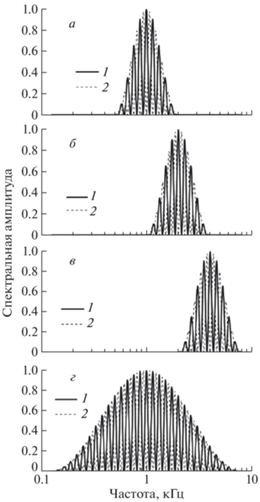
Спектр тест-сигнала имел гребенчатую структуру. Гребенчатый характер спектра задавался смещенной косинусоидой от логарифма частоты, т.е. задавался формулой
где A – спектральная амплитуда, f – частота в октавах относительно 1 кГц, f0 – центральная частота гребня в октавах относительно 1 кГц, D – плотность гребней в цикл/окт. Гребни, заданные этой функцией, характеризуются изменениями спектральной амплитуды от 1 на вершине гребня до 0 в провалах между гребнями. Плотность гребней варьировали ступенчато, принимая значения 2, 3, 5, 7, 10, 15, 20, 30, 50, 70, 100, 150, 200 цикл/окт (квазилогарифмическая шкала с дробностью шести значений на десятичную логарифмическую единицу). В тест-сигнале каждые 400 мс происходила реверсия фазы гребней: положения максимумов и минимумов гребенчатого рисунка менялись местами на шкале частот (варианты спектра 1 и 2 на рис. 1).Сигнал содержал шесть сегментов с противоположными фазами гребней, т.е. общая длительность тест-сигнала составляла 2400 мс.
В качестве референтного применяли один из двух типов сигнала: с гребенчатым спектром (гребенчатый) или со спектром без гребенчатого рисунка (плоский). Гребенчатый референтный сигнал имел те же – длительность, уровень, спектральную полосу, плотность и глубину гребней, что и тест-сигнал. Отличие референтного сигнала от тест-сигнала состояло в том, что отсутствовала периодическая реверсия фазы гребней: фаза оставалась неизменной в течение всей продолжительности сигнала, которая составляла 2400 мс. Плоский референтный сигнал имел те же длительность, уровень и спектральную полосу, что и тест-сигнал.
Уровень сигналов выбирали в зависимости от порога обнаружения тона испытуемого на выбранной частоте, применяя формулу
где L (дБ уровня звукового давления, УЗД) – уровень и T (дБ УЗД) – порог обнаружения тона на центральной частоте узкополосного (2 окт) сигнала или на частоте 1 кГц для широкополосного сигнала. При применении такой формулы минимальный уровень сигнала, который использовался для испытуемых без потери слуха (T = 0 дБ), составил 70 дБ УЗД, а максимальный уровень для испытуемого со значительной потерей слуха (T = = 60 дБ) составил 100 дБ УЗД. Приведенная простая формула удовлетворительно аппроксимировала уровни сигналов, выбираемые самими испытуемыми как комфортные для различения тестового и референтного сигналов, но не создающие дискомфорт из-за излишней громкости (см. Результаты).Все сигналы синтезировали цифровым способом с использованием стандартного персонального компьютера и программы собственной разработки в программной оболочке LabVIEW (National Instruments, США) при частоте стробирования 32 кГц. Дискретность синтезированного сигнала составляла 217 = 131 072 точек (4096 точек/кГц). Сигналы, синтезированные в цифровой форме, преобразовывали в аналоговую форму 16-битным цифроаналоговым преобразователем, входящим в состав платы сбора данных NI-DAQ-6215 (National Instruments). Аналоговые сигналы воспроизводили диотически (одинаково на оба уха испытуемого) через головные телефоны Schenheiser HD580 (Sennheiser, Wedemark, ФРГ). Выходная мощность цифроаналогового преобразователя была достаточной для подключения головных телефонов, так что дополнительный усилитель мощности не требовался.
Для контроля параметров звуковых сигналов использовали “искусственное ухо” RA0039 (G.R.A.S., Holte, Дания).
Процедура измерений
Частотно разрешающую способность характеризовали как предельную разрешаемую плотность гребней частотного спектра. Разрешение гребенчатых спектров измеряли, применяя трехальтернативную процедуру с принудительным выбором в сочетании с адаптивным варьированием плотности гребней. В каждой пробе испытуемому предъявляли последовательность из трех сигналов длительностью 2400 мс, разделенных паузами длительностью 100 мс. Последовательность состояла из одного тестового и двух референтных сигналов. Референтные сигналы были одного и того же типа, т.е. либо оба с гребенчатым спектром, либо оба с плоским спектром. Они имели одинаковые статистические параметры, но не были копиями друг друга, а различались случайными флуктуациями, свойственными шумовым сигналам. Порядок чередования сигналов в предъявляемой последовательности (тест-сигнал в первой, второй или третьей позиции) варьировал от пробы к пробе в случайном порядке. Задача испытуемого состояла в том, чтобы указать, какой из трех сигналов отличался от двух других, т.е. какой из них был тестовым.
Плотность гребней варьировали от пробы к пробе адаптивно по правилу “два–вверх, один–вниз”. Если испытуемый один раз правильно указывал на положение тест-сигнала в последовательности из трех сигналов (угадывание), то в следующей пробе плотность гребней оставалась неизменной. После двух последовательных угадываний в следующей пробе плотность гребней повышали на один шаг. Если испытуемый неправильно указывал на положение тест-сигнала в последовательности (ошибка), плотность гребней в следующей пробе снижали на один шаг. Такое варьирование приводило плотность гребней к значению, обеспечивающему вероятность правильных ответов 71% (Levitt, 1971). Это значение принимали за порог различения (разрешение) гребенчатого рисунка спектров, поскольку оно было близко к среднему значению (67%) между безошибочным распознаванием тест-сигнала (100%) и случайным угадыванием одного из трех сигналов (33%). Адаптивное варьирование плотности гребней продолжали до тех пор, пока не получали 10 точек реверсии (переход от повышения плотности гребней к понижению и обратно).
Геометрическое среднее полученных таким образом 10 значений плотности гребней принимали за оценку разрешения в данном эксперименте.
Геометрическое, а не арифметическое, среднее использовали ввиду того, что плотность гребней варьировали шагами, более близкими к логарифмической, чем к линейной шкале.
На каждом испытуемом измерение порогов повторяли 3 раза. Арифметическое среднее и стандартное отклонение трех полученных результатов принимали за окончательную оценку разрешения для данного испытуемого.
РЕЗУЛЬТАТЫ
Тональная аудиометрия
Измерение порогов обнаружения тона показало явную тенденцию зависимости порога от возраста: чем старше испытуемые, тем чаще были повышены пороги на всех трех частотах (1, 2 и 4 кГц). У большинства испытуемых старше 60 лет наблюдали повышенные пороги обнаружения тонов, хотя у части испытуемых пороги были в пределах нормы (рис. 2).
Рис. 2.
Зависимость порогов обнаружения тона от возраста испытуемого на частотах от 1 кГц (а), 2 кГц (б) и 4 кГц (в).
Сплошная линия – линия регрессии, пунктирные линии – 95%-ная доверительная область.
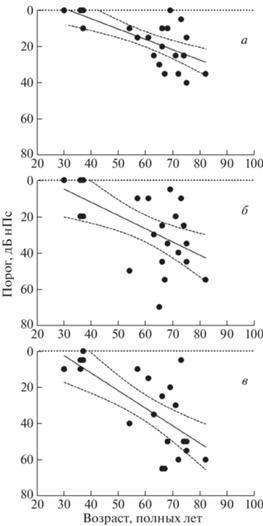
Несмотря на значительный межиндивидуальный разброс данных, корреляция порогов обнаружения тона и возраста была статистически значимой: коэффициенты корреляции Пирсона для частот 1, 2 и 4 кГц составили соответственно r = = 0.69 (p = 0.0002), r = 0.58 (p = 0.0035) и r = 0.71 (p = 0.0002).
Зависимость разрешения плотности гребней от порогов обнаружения тонов при гребенчатом референтном сигнале: узкополосные сигналы
При всех частотных полосах сигнала (2-октавные центрированные на 1, 2 и 4 кГц и 6-октавная) ЧРС мало зависело от частоты сигнала. У испытуемых без потери слуха (порог обнаружения тона от 0 до 25 дБ УЗД) ЧРС составляла от 8.5 до 9.8 цикл/окт, что близко к ранее полученным тем же методом данным на нормально слышащих испытуемых (Nechaev et al., 2019; Milekhina et al., 2019).
У испытуемых с повышенными порогами обнаружения тона спектральное разрешение было снижено по сравнению с нормально слышащими испытуемыми. Несмотря на значительный меж-индивидуальный разброс данных, имела место тенденция: чем выше порог обнаружения тона, тем ниже спектральное разрешение (рис. 3).
Рис. 3.
Зависимость ЧРС от порогов обнаружения тонов при измерениях с гребенчатыми референтными сигналами.
а–в – сигналы с шириной спектральной полосы 2 окт, центрированные на частоте 1 кГц (а), 2 кГц (б) и 4 кГц (в). Точечные символы – данные для испытуемых с различными порогами обнаружения тона, наклонные прямые пунктирные линии – линии регрессии, аппроксимирующие экспериментальные данные, пунктирные линии – 95%-ная доверительная область для значений.
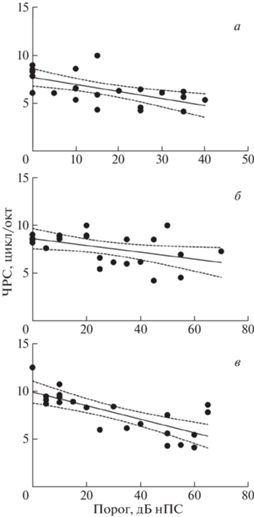
Корреляция ЧРС и порогов обнаружения тона была статистически значимой: коэффициенты корреляции Пирсона для частот 1, 2 и 4 кГц составили соответственно r = –0.6 (p = 0.0026), r = = –0.45 (p = 0.032) и r = –0.74 (p < 0.0001). Наклон (со стандартной ошибкой) линии регрессии, аппроксимирующей зависимость ЧРС от порога обнаружения тона, составил –0.07 ± 0.02, –0.04 ± 0.02 и –0.07 ± 0.01 (цикл/окт)/дБ, для частот соответственно 1, 2 и 4 кГц. Во всех случаях 95%-ный доверительный интервал для наклона линии регрессии лежал в области отрицательных значений. Это значит, что отрицательная зависимость спектрального разрешения от порога обнаружения тона (чем выше порог, тем хуже разрешение) была статистически достоверной.
Зависимость разрешения плотности гребней от порога обнаружения тона при плоском референтном сигнале: узкополосные сигналы
В экспериментах, в которых испытуемый должен был отличать гребенчатый тест-сигнал от плоских референтных сигналов, были получены более высокие оценки спектральной разрешающей способности, чем при различении гребенчатых спектров с разной фазой гребней. У испытуемых с нормальным слухом (пороги обнаружения тона ниже 25 дБ) разрешение зависело от центральной частоты сигнала: составляло от 11 до 15.5 (цикл/окт)/дБ при центральной частоте сигнала 1 кГц, от 21 до 104 (цикл/окт)/дБ при центральной частоте 4 кГц. Эти значения близки к ранее полученным данным для нормальных испытуемых (Nechaev et al., 2019; Milekhina et al., 2019).
У испытуемых с повышенными порогами обнаружения тона разрешение гребенчатой структуры спектра также зависело от центральной частоты сигнала: чем выше частота, тем лучше в среднем разрешение. Снижение спектральной разрешающей способности по мере повышения порогов обнаружения тона было менее выраженным, чем при гребенчатом референтном сигнале (рис. 4).
Наклоны линий регрессии, аппроксимирующих зависимость спектрального разрешения от порога обнаружения тона на центральной частоте сигнала, и их стандартные отклонения составили –0.08 ± 0.08 (цикл/окт)/дБ для сигналов, центрированных на частоте 1 кГц, –0.20 ± 0.11 для частоты 2 кГц и –0.22 ± 0.19 для частоты 4 кГц. При этом 95%-ный доверительный интервал занимал диапазон от положительных до отрицательных значений, т.е. отрицательный наклон линии регрессии не достигал статистической достоверности. Достоверной корреляции между порогами спектрального разрешения и порогами обнаружения тона для плоского референтного сигнала обнаружено не было: коэффициенты корреляции для частот 1, 2 и 4 кГц составили, соответственно, r = –0.2 (p = 0.35), r = –0.37 (p = 0.078) и r = –0.25 (p = 0.26).
Зависимость разрешения плотности гребней от возраста при гребенчатом и плоском референтном сигналах
Была проанализирована связь между возрастом испытуемого и ЧРС при плоском и гребенчатом референтных сигналах (рис. 5).
Рис. 5.
Зависимость ЧРС от возраста для гребенчатого и плоского референтных сигналов и разных центральных частот
а – 1 кГц; б – 2 кГц; в – 4 кГц; г – широкополосный сигнал. Точечные символы – данные для испытуемых с различными порогами обнаружения тона, наклонные прямые линии – линии регрессии, аппроксимирующие экспериментальные данные, пунктирные линии – 95%-ная доверительная область для значений.
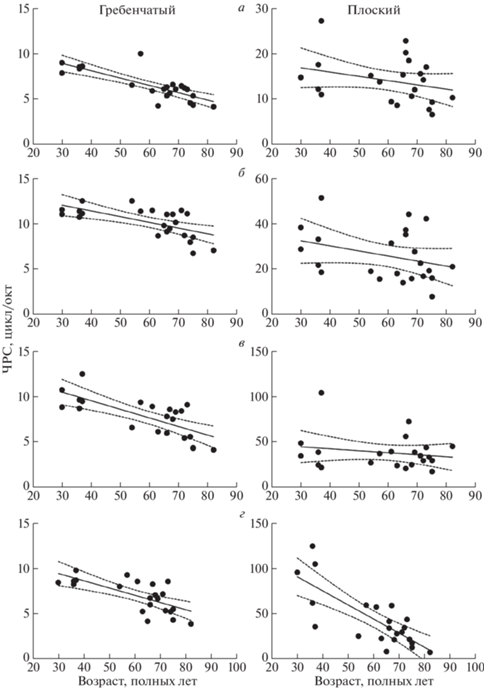
Корреляция ЧРС с возрастом была статистически значимой при всех значениях центральной частоты спектра, а также для широкополосного спектра. При референтном сигнале с гребенчатым спектром коэффициенты корреляции составили: для центральной частоты 1 кГц r = –0.8 (p < < 0.0001), для частоты 2 кГц r = –0.63 (p = 0.001), для частоты 4 кГц r = –0.72 (p < 0.0001), для широкой полосы r = –0.69 (p < 0.0004). При плоском референтном сигнале корреляция ЧРС с возрастом была статистически значимой только для широкополосного сигнала: коэффициенты корреляции для частоты 1 кГц r = –0.31 (p = 0.15), для частоты 2 кГц r = –0.32 (p = 0.13), для частоты 4 кГц r = –0.19 (p = 0.4), и для широкополосного сигнала r = –0.77 (p < 0.0001).
ОБСУЖДЕНИЕ
Возрастные изменения как причина снижения слуха у испытуемых
В данной работе участвовали испытуемые с различной степенью потери слуха. Наблюдалась явная корреляция слуховых порогов обнаружения тона с возрастом. В анамнезе испытуемых не значились перенесенные травмы, инфекционные заболевания и тому подобное, поэтому мы полагаем, что основной причиной дефицита слуха были возрастные изменения (пресбикузис).
В то же время зависимость от возраста характеризовалась значительным межиндивидуальным разбросом данных. Это означает, что наряду с возрастом на пороги влияли другие факторы, которые не могли быть учтены в данной работе. Строго говоря, поскольку из факторов, влияющих на характеристики слуха, учитывали только возраст, полученные данные об изменениях ЧРС следует отнести только к возрастным изменениям слуха. Однако связь снижения ЧРС с повышением порогов обнаружения тона, продемонстрированная в данной работе, может быть отнесена и к случаям потери слуха другой этиологии.
Снижение ЧРС вследствие дисфункции спектрального механизма
Возрастные изменения слуха включают в себя нарушение частотной избирательности. Изменение частотной избирательности хорошо моделируется изменением ширины слуховых частотно-избирательных фильтров (Glasberg, Moore, 1986).
Согласно ранее опубликованным данным (см. Введение), при измерениях, основанных на различении тестового и референтного гребенчатых сигналов, выявляются возможности спектрального механизма ЧРС, основанного на сравнении профилей возбуждения, создаваемых тестовым и референтным сигналами на выходе слуховых фильтров.
Полученные данные согласуются с ранее проведенными исследованиями. В работе (Nambi et al., 2016) было показано снижение различения гребенчатой структуры спектра почти в 2 раза у группы испытуемых старше 51 года (c 8 до 4 цикл/окт). Мы предполагаем, что более значительное изменение связано с иной схемой предъявления стимулов. В работе (Narne et al., 2016) ухудшение спектрального различения моделировалось путем “размазывания” спектра сигнала. Чем сильнее было “размазывание” гребенчатого спектра, тем сильнее ухудшалось его различение. Такой результат хорошо согласовывался с предсказанием, основанным на построении профилей возбуждения.
Полученные в данном исследовании экспериментальные данные также хорошо согласуются с моделью, основанной на сравнении профилей возбуждения. При работе спектрального механизма различения ЧРС зависит от соотношения плотности гребней в сигнале и остроты настройки кохлеарных частотно-избирательных фильтров. Согласно формуле, обобщающей результаты измерений остроты настройки фильтров методами маскировки (Glasberg, Moore, 1986), острота настройки фильтров мало зависит от частоты в диапазоне частот выше 1 кГц: у нормально слышащих испытуемых полоса пропускания фильтров меняется от 13% на частоте 1 кГц до 11% на частоте 4 кГц. Плотность гребней в сигналах, использованных в настоящей работе, также задавалась постоянной в пределах частотной полосы сигнала. Поэтому соотношение плотности гребней и остроты настройки фильтров мало зависело от того, воздействовал ли сигнал на относительно узкую полосу частот (сигналы, центрированные на 1, 2 или 4 кГц) или на широкую полосу (от 0.125 до 8 кГц). ЧРС, определяемая спектральным механизмом, должна незначительно зависеть от спектральной полосы сигнала, что и наблюдали в данном исследовании.
Согласие полученных экспериментальных данных с моделью профиля возбуждения проиллюстрировано на рис. 6.
Рис. 6.
Модель профиля возбуждения.
а – спектр сигнала с шириной спектральной полосы 2 окт, центрированного на частоте 2 кГц, с плотностью гребней 9 цикл/окт; б – профиль возбуждения, полученный сверткой спектра (а) с частотной характеристикой фильтра с эквивалентной полосой пропускания 12.5% от частоты настройки; в и г – то же, что а и б для плотности спектральных гребней 4.5 цикл/окт, и полосы пропускания фильтра 25%.
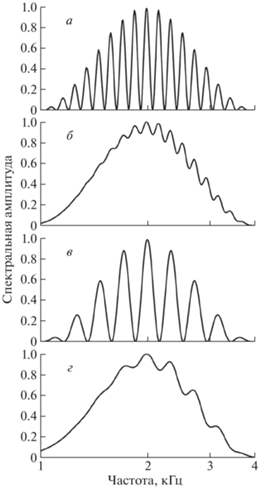
Спектр входного сигнала (рис. 6, а) имеет плотность гребней 9 цикл/окт, что близко к оценке ЧРС у испытуемых с нормальным слухом. При прохождении через гребенку фильтров с полосой пропускания 12.5% от частоты настройки (это значение диктуется формулой, приведенной в работе (Glasberg, Moore, 1986) такой сигнал создает профиль возбуждения, приведенный на рис. 6, б. Глубина гребней в центре профиля возбуждения составляет около 1 дБ, что можно принять за порог различения гребенчатой структуры спектра. Если полоса пропускания слуховых фильтров расширена до 25%, то входной сигнал плотностью гребней 4.5 цикл/окт (рис. 6, в) создает профиль возбуждения с такой же глубиной гребней (рис. 6, г), т.е. при снижении остроты настройки фильтра пороговой становится пропорционально сниженная плотность гребней.
Снижение ЧРС вследствие дисфункции временного механизма
Временной анализ сигналов со сложными спектрами происходит в слуховых нервных центрах, куда поступает афферентный поток импульсов от слуховой улитки, и снижение остроты настройки кохлеарных частотно-избирательных фильтров не должно влиять на ЧРС. Настоящее исследование исходило из того, что временной механизм играет решающую роль, если ЧРС измеряется на основе различения гребенчатого тест-сигнала и плоского референтного сигнала. Поэтому при применении плоских референтных сигналов не должно быть корреляции ЧРС с порогами обнаружения тона.
Действительно, для узкополосных сигналов ЧРС не зависела от порогов обнаружения тона (рис. 4, а–в).
Модель временного анализа основана на том, что временная организация гребенчатых сигналов проявляется в их автокорреляционных функциях (АКФ), которые содержат задержанный сегмент (рис. 7, а–в). АКФ плоского сигнала не имеет такого задержанного сегмента (рис. 7, г).
Рис. 7.
АКФ сигналов с шириной спектральной полосы 2 окт.
а – сигнал с гребенчатым спектром, центральная частота 4 кГц, плотность гребней 40 цикл/окт; б – то же, 2 кГц, 20 цикл/окт; в – то же, 1 кГц, 10 цикл/окт; г – АКФ сигнала с плоским спектром.
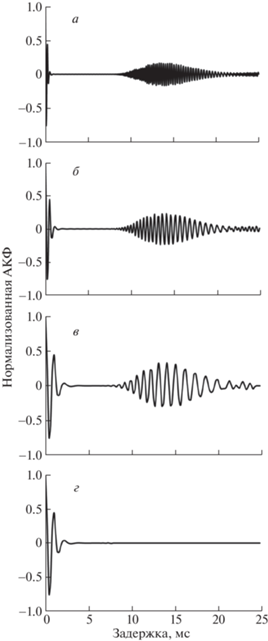
Задержка равна обратной величине от частотного интервала между гребнями:
где τ – задержка, f – частота, D = f/δf – плотность гребней и δf – частотный интервал между соседними гребнями, т.е. задержка прямо пропорциональна плотности гребней и обратно пропорциональна частоте сигнала.Рисунок 7 показывает АКФ гребенчатых спектров для сигналов с разной центральной частотой и разной плотностью гребней. При центральной частоте сигнала 4 кГц и плотности гребней 40 цикл/окт задержанный сегмент АКФ перекрывает диапазон задержек от 10 до 20 мс (рис. 7, а). Поскольку плотность гребней 40 цикл/окт близка к среднему экспериментально найденному пределу выявления гребенчатой структуры спектра, можно предположить, что данная задержка – предельная, при которой возможно выявление временной организации сигнала. При центральной частоте 2 кГц такая же задержка сегмента АКФ возникает при плотности гребней 20 цикл/окт (рис. 7, б), а при частоте 1 кГц – при плотности 10 цикл/окт (рис. 7, в), что близко к средним экспериментальным значения порога. Таким образом, при изменении частоты сигнала условия выявления задержанного сегмента АКФ сохраняются, если пропорционально частоте меняется плотность гребней.
Изначально предположение о роли временного анализа в различении гребенчатого спектра было сделано для объяснения явления ощущения “высоты повторений” (repetition pitch). “Cила ощущения высоты” (pitch strength) связана с доминантным участком, который соответствует частотной области в 3–5 раз выше обратного значения интервала между гребнями в спектре (Yost, 1982). Необходимо отметить, что при нарушениях слуха “ощущение высоты” сохранялось, но изменялась “сила ощущения высоты”. Наибольшие различия наблюдались для сигналов с частотной полосой выше 1000 Гц, что соответствует областям с большей потерей слуха. Вероятно, что в отличие от самого “ощущения высоты”, снижение “силы ощущения высоты” связано с расширением слуховых фильтров (Leek, Summers, 2001). Однако использование шумов с различной шириной частотной полосы показало, что “сила ощущения высоты” у испытуемых с нарушением слуха слабее, и результат не может быть до конца объяснен только работой спектрального механизма. Снижение возможности использовать тонкую временную структуру сигнала также может играть роль (Horbach et al., 2018).
Можно предположить, что признак, позволяющий отличить гребенчатый спектр с частотно-пропорциональными гребнями от сплошного, также связан с “ощущением высоты”. Тогда, возможно, “сила ощущения высоты” такого сигнала уменьшается при нарушении слуха вследствие расширения слуховых фильтров.
Связь снижения ЧРС с возрастом
При использовании референтного сигнала с гребенчатым спектром слуховая система адресуется к спектральному механизму частотного анализа. При этом выявляется связь между возрастом испытуемых и ЧРС. Объяснение данного результата может состоять в том, что возрастные изменения слуховой системы включают падение остроты настройки слуховых фильтров. Это приводит к снижению различения плотности гребней спектра.
При использовании референтного сигнала с плоским спектром связь между возрастом и ЧРС была обнаружена только для широкополосного сигнала. Возможно, связь между возрастом и ЧРС для центральных частот 1, 2 и 4 кГц не удалось выявить из-за большого разброса данных.
Различие результатов для сигналов с узкополосным и широкополосным спектром может возникать из-за выбора уровня узкополосных сигналов, так что сигнал был слышен даже при значительной потере слуха. При этом относительно высокие значения ЧРС получали даже на испытуемых со сниженным слухом, поскольку обеспечивали слышимость сигналов в диапазоне относительно высоких частот, где различается наиболее высокая плотность гребней. При предъявлении широкополосного сигнала оценка ЧРС зависит от той части его спектральной полосы, которая обеспечивает наивысшее разрешение, т.е. в диапазоне высоких частот. Поэтому у испытуемых с нормальным слухом получена высокая ЧРС от 30 до 120 цикл/окт, но у испытуемых с выраженной тугоухостью частоты широкополосного сигнала от 4 кГц и выше не могут восприниматься, и оценка ЧРС зависит от анализа сигналов в доступной полосе частот, например около 2 кГц. В этом случае получали ЧРС около 20 цикл/окт. Если и частоты около 2 кГц не воспринимаются, то оценка ЧРС определяется частотами около 1 кГц и ниже, так что они составляют 10 цикл/окт и менее. В результате получали значительную зависимость ЧРС от степени тугоухости (рис. 4, г).
Таким образом, модель временного анализа удовлетворительно объясняет полученную зависимость оценок ЧРС от порогов обнаружения тона и возраста при условии применения плоских референтных сигналов.
ЗАКЛЮЧЕНИЕ
Для различения сигналов по спектральному механизму решающее значение имеет соотношение дробности спектрального рисунка и остроты настройки частотно-избирательных фильтров. В значительной части слухового диапазона острота настройки фильтров слабо зависит от частоты. Поэтому получаемые оценки ЧРС слабо зависели от того, в какой части слухового диапазона частот выполнены измерения.
При возрастной потере слуха прежде всего страдает восприятие высоких частот, но сохранившееся восприятие низких частот может обеспечить практически такое же частотное разрешение по спектральному механизму, как восприятие высоких частот при нормальном слухе. Этот вывод объясняет, почему в ряде случаев применение слуховых аппаратов пациентами с тугоухостью может не давать положительного эффекта: слуховой аппарат увеличивает громкость звука и при правильной настройке частотной характеристики усилителя восстанавливает восприятие высоких частот, но не повышает остроту настройки слуховых фильтров. Поэтому в тех случаях, когда ЧРС обусловлена спектральным механизмом, применение слухового аппарата не обеспечивает нормальное различение сложных сигналов.
При различении сигналов по временному механизму важную роль играет частота сигналов: на высоких частотах могут различаться более дробные спектральные рисунки. Поэтому выпадение восприятия высоких частот при тугоухости – одна из причин сниженной ЧРС. Восприятие высоких частот в результате применения сигналов достаточно высокой интенсивности приводит к восстановлению ЧРС. Этот эффект может быть достигнут восстановлением восприятия высоких частот слуховым аппаратом.
Таким образом, эффективность слухового аппарата как средства восстановления ЧРС зависит от того, какой механизм – спектральный или временной – играет ведущую роль в различении сигналов. Роли же спектрального и временного механизмов в свою очередь зависят от характера сигналов, подлежащих различению. В данном исследовании это показано на примере экспериментов с применением гребенчатого или плоского референтного сигналов.
Список литературы
Anderson E.S., Oxenham A.J., Nelson P.B., Nelson D.A. Assessing the role of spectral and intensity cues in spectral ripple detection and discrimination on cochlear-implant users. J. Acoust. Soc. Am. 2012. V. 132. P. 3925–3934. https://doi.org/10.1121/1.4763999
Bernstein J.G.W., Golbarg M.G., Shamma S., Gallun F.J., Theodoroff S.M., Leek M.R. Spectrotemporal modulation sensitivity as a predictor of speech intelligibility for hearing-impaired listeners. J. Am. Acad. Audiol. 2013. V. 24. P. 293–306. https://doi.org/10.3766/jaaa.24.4.5
Bilsen F.A., Ritsma R.J. (1970) Some parameters influencing the perceptibility of pitch. J. Acoust. Soc. Am. 1970. V. 47. P. 469–475. https://doi.org/10.1121/1.1911916
Chi T., Gao Y., Guyton M.C., Ru P., Shamma S. (1999). Spectro-temporal modulation transfer functions and speech intelligibility. J. Acoust. Soc. Am., 1999. V. 106. P. 2719–2732. https://doi.org/10.1121/1.428100
Davies-Venn E., Nelson P., Souza P. Comparing auditory filter bandwidths, spectral ripple modulation detection, spectral ripple discrimination, and speech recognition: Normal and impaired hearing. J. Acoust. Soc. Am. 2015. V. 138. P. 492–503. https://doi.org/10.1121/1.4922700
Festen J.M., Plomp R. Relations between auditory functions in impaired hearing. J. Acoust. Soc. Am. 1983. V. 73. P. 652–662. https://doi.org/10.1121/1.388957
Glasberg B.R., Moore B.C.J. Auditory filter shapes in subjects with unilateral and bilateral cochlear impairments. J. Acoust. Soc. Am. 1986. V. 79. P. 1020–1033. https://doi.org/10.1121/1.393374
He N., Mills J.H., Ahlstrom J.B., Dubno J.R. Age-related differences in the temporal modulation transfer function with pure-tone carriers. J. Acoust. Soc. Am. 2008. V. 124. P. 3841–3849. https://doi.org/10.1121/1.2998779
Henry B.A., Turner C.W., Behrens A. Spectral peak resolution and speech recognition in quiet: Normal hearing, hearing impaired, and cochlear implant listeners. J. Acoust. Soc. Am. 2005. V. 118. P. 1111–1121. https://doi.org/10.1121/1.1944567
Hopkins K., Moore B.C.J. (2011) The effects of age and cochlear hearing loss on temporal fine structure sensitivity, frequency selectivity, and speech reception in noise. J. Acoust. Soc. Am. 2011. V. 130. P. 334–349. https://doi.org/10.1121/1.3585848
Horbach M., Verhey J.L., Hots J. On the pitch strength of bandpass noise in normal-hearing and hearing-impaired listeners. Trends in Hearing. 2018. V. 22. P. 1–14. https://doi.org/10.1177/2331216518787067
Krumbholz K., Patterson R.D., Nobbe A. Asymmetry of masking between noise and iterated rippled noise: Evidence for time interval processing in the auditory system. J. Acoust. Soc. Am. 2001. V. 110. P. 2096–2107. https://doi.org/10.1121/1.1395583
Leek M.R., Summers V. Auditory filter shapes of normal-hearing and hearing-impaired listeners in continuous broadband noise. J. Acoust. Soc. Am. 1993. V. 94. P. 3127–3137. https://doi.org/10.1121/1.407218
Leek M.R., Summer V. Pitch strength and pitch dominance of iterated rippled noises in hearing-impaired listeners. J. Acoust. Soc. Am. 2001. V. 109. P. 2944–2954. https://doi.org/10.1121/1.1371761
Levitt H. Transformed up-down methods in psychoacoustics. J. Acoust. Soc. Am. 1971. V. 49. P. 467–477. https://doi.org/10.1121/1.1912375
Litvak L.M., Spahr A.J., Saoji A.A., Fridman G.Y. Relationship between the perception of spectral ripple and speech recognition in cochlear implant and vocoder listeners. J. Acoust. Soc. Am. 2007. V. 122. P. 982–991. https://doi.org/10.1121/1.2749413
Mehraei G., Gallun F.J., Leek M.R., Bernstein J.G. Spectrotemporal modulation sensitivity for hearing-impaired listeners: Dependence on carrier center frequency and the relationship to speech intelligibility. J. Acoust. Soc. Am. 2014. V. 136. P. 301–316. https://doi.org/10.1121/1.4881918
Milekhina O.N., Nechaev D.I., Supin A.Y. Rippled-spectrum resolution dependence on frequency: Estimates obtained by discrimination from rippled and nonrippled reference signals. J. Acoust. Soc. Am. 2019. V. 146. P. 2231–2239. https://doi.org/10.1121/1.5127835
Moore B.C.J., Vickers D.A., Plack C.J., Oxenham A.J. Inter-relationship between different psychoacoustic measures assumed to be related to the cochlear active mechanism. J. Acoust. Soc. Am. 1999. V. 106. P. 2761–2778. https://doi.org/10.1121/1.428133
Nambi P.M.A., Sangamanatha A.V., Vikas M.D., Bhat J.S., Shama K. Perception of spectral ripples and speech perception in noise by older adults. Ageing International. 2016. V. 41. https://doi.org/10.1007/s12126-016-9248-4
Narne V.K., Sharma M., Van Dun B., Bansal S., Prabhu L., Moore B.C.J. Effects of spectral smearing on performance of the spectral ripple and spectro-temporal ripple test. J. Acoust. Soc. Am. 2016. V. 140. P. 4298–4306. https://doi.org/10.1121/1.4971419
Nechaev D.I., Milekhina O.N., Supin A.Y. Estimates of ripple-density resolution based on the discrimination from rippled and nonrippled reference signals. Trends in Hearing. 2019. V. 23. https://doi.org/10.1177/2331216518824435
Patterson R.D., Nimmo-Smith I., Weber D.L., Milory R. The deterioration of hearing with age: Frequency selectivity, the critical ratio, the audiogram, and speech threshold. J. Acoust. Soc. Am. 1982. V. 72. P. 1788–1803. https://doi.org/10.1121/1.388652
Patterson R.D., Handel S., Yost W.A., Datta A.J. The relative strength of the tone and noise components in iterated rippled noise. J. Acoust. Soc. Am. 1996. V. 100. P. 3286–3294. https://doi.org/10.1121/1.417212
Plomp R. Auditory handicap of hearing impairment and the limited benefit of hearing aids. J. Acoust. Soc. Am. 1978. V. 63. P. 533–549. https://doi.org/10.1121/1.381753
Souza P.E., Boike K.T., Witherell K., Tremblay K.L. Prediction of speech recognition from audibility in older listeners with hearing loss: Effects of age, amplification, and background noise. J. Am. Acad. Audiol. 2007. V. 18. P. 54–65. https://doi.org/10.3766/jaaa.18.1.5
Stein A., Ewert S.D., Wiegrebe L. Perceptual interaction between carrier periodicity and amplitude modulation in broadband stimuli: A comparison of the autocorrelation and modulation-filterbank model. J. Acoust. Soc. Am. 2005. V. 118. P. 2470–2481. https://doi.org/10.1121/1.2011427
Supin A.Ya., Popov V.V., Milekhina O.N., Tarakanov M.B. Ripple depth and density resolution of rippled noise. J. Acoust. Soc. Am. 1999. V. 106. P. 2800–2804. https://doi.org/10.1121/1.428105
Supin A.Ya., Milekhina O.N., Nechaev D., Tomozova M. Ripple density resolution dependence on ripple width. PLoS ONE. 2022. V. 17. e0270296. https://doi.org/10.1371/journal.pone.0270296
Yost W.A. The dominance region and ripple noise pitch: A test the peripheral weighting model. J. Acoust. Soc. Am. 1982. V. 72. P. 416–425. https://doi.org/10.1121/1.388094
Yost W.A. Pitch strength of iterated rippled noise. J. Acoust. Soc. Am. 1996. V. 100. P. 3329–3335. https://doi.org/10.1121/1.416973
Yost W.A., Patterson R.D., Sheft S. (1996). A time domain description for the pitch strength of iterated rippled noise. J. Acoust. Soc. Am. 1996. V. 99. P. 1066–1078. https://doi.org/10.1121/1.414593
Yost W.A., Patterson R., Sheft S. The role of the envelope in processing iteration rippled noise. J. Acoust. Soc. Am. 1998. V. 104. P. 2349–2361. https://doi.org/10.1121/1.423746
Zwicker E. Masking and psychophysical excitation as consequences of the ear’s frequency analysis. Frequency analysis and periodicity detection in hearing. Eds. Plomp R., Smoorenburg G.F. Leiden, the Netherlands: Sijthoff, 1970. P. 376–394.
Дополнительные материалы отсутствуют.
Инструменты
Сенсорные системы



